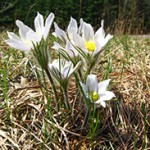Flowering Dates Influenced by Record Warm Spring of 2012
From the Aldo Leopold Foundation:
Senior Fellow Stan Temple of the Aldo Leopold Foundation, along with scientists from Boston and Harvard Universities, used data from long-term phenology records initiated by Aldo Leopold and Henry David Thoreau to examine the relationship between spring temperatures and flowering dates. Those historical relationships allowed them to correctly predict how spring wildflowers responded to record-setting warm temperatures in 2012.
Their research shows that spring flowering is still coming earlier and earlier as spring temperatures rise. If there are physiological constraints limiting how early plants can flower, they have not yet been reached. These results can help to predict plant responses to a warmer climate, essential for commercial production in spring-flowering fruit trees and other crops.
They also indicate that a continued trend of earlier flowering may pose problems for pollination if responses of pollinators to climatic changes don’t keep pace. Learn more about the ongoing phenology work of the Aldo Leopold Foundation (and find additional links to media coverage of this study) on our website.
The spring of 2012 was off the charts. The average temperature in south-central Wisconsin was 12.2 degrees C during March, April and May. In response to the record warmth 22 of the 23 species monitored every year since 1935 bloomed at all-time record dates. For example, in 1942 when the average spring temperature was 9.0 degrees C, bloodroot bloomed on April 12. In 2012, when the average spring temperature was 12.2 degrees C, bloodroot bloomed on March 17. Similar results were recorded in Massachusetts.
On average the 23 monitored species have bloomed 4.1 days earlier for each 1 degree C rise in average spring temperature, and that relationship is highly significant. From 1935-45 the average spring temperature was 7.5 degrees C, and the 23 species bloomed on average on May 7. During 2002-2012, the average spring temperature had risen to 9.3 degrees C, and the 23 plants bloomed on average on May 1. In Massachusetts, the monitored species bloomed 3.2 days earlier for each 1 degree C rise in spring temperature.
The strong historical relationships between spring temperatures and flowering dates suggest that we might be able to extrapolate and predict what flowering dates might be under increasingly warmer spring temperatures. To test the power of the historical data, pre-2012 data was used to predict what flowering dates would be under the record-breaking warmth of 2012. The historical data correctly predicted the flowering times with 95% certainty. This is an important finding because there have been suggestions that flowering won’t be able to keep pace with unprecedented warm temperatures.
Every year, the Aldo Leopold Weekend takes place on the first weekend in March across Wisconsin. This year marked the 13th annual statewide celebration. Now, communities across the country are beginning to adopt the celebration–this year the Foundation is proud to have helped support events in Arkansas, Iowa, and Minnesota!
Read past e-Newsletters of the Aldo Leopold Foundation here.

